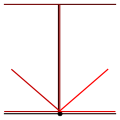Heian Shodan
Heian Shodan or Pinan Nidan ( Japanese平安 初段 or 平安 二段, consisting of the word parts peace (平安) and an initial stage (初段) or second stage (二段)) is a kata (a stylized fight against imaginary opponents ) in karate , which forms the first - in some styles second - of a series of five kata called Heian or Pinan.
Here the Kata Heian Shodan from the Shōtōkan style is described. This corresponds (apart from style differences) to the Kata Pinan Nidan z. B. in Wadō-Ryū , however, the Pinan Shodan in Kyokushinkai . The Kata Pinan Shodan can either correspond to the Kata Heian Shodan or the Heian Nidan , depending on the style .
Surname
The name of the series 平安, i.e. Heian according to the Japanese version, originally comes from Chinese, where it is transcribed as píng'ān . From this the reading Pinan developed in Okinawa , which is still widely used today as the name of the Kata series. It literally means peace , but also (inner) calm , calmness of mind , peace of mind or a peaceful spirit .
Shodan初段 and Nidan二段 are called the lowest level and second level .
development
Because the old masters did not record anything until the early twentieth century and only passed on karate - often in secret - orally and practically, the origins of the kata can no longer be proven beyond doubt.
Based on the Chinese-influenced reading in Okinawa, where the kata was first taught, it can be concluded that it is of Chinese origin. The clear relationship between the Heian series and the Kata Kushanku , which has been proven to have come to Okinawa from China, provides further evidence that it was either developed from the latter or that it comes from a similar source on mainland China. The Passai is also said to have served as a supplier of techniques and sensations in the development of the series, which is quite understandable when looking at the Katas. Another theory is that the Chanan-Kata (Chiangnan) was the inspiration for the development of the Heian series. This kata no longer exists in its original form today and can therefore not provide evidence.
The development of the Pinan series is often attributed to Master Itosu Ankō , but this has not been proven. Of Nakama Chozo that Itosu has the Katas of Nakahara, one of his teachers learned is claimed. It is known that Itosu systematized the series and processed it for his students. Many open hand or finger stab techniques have been replaced by the closed fist. This reduced the risk of injury to the students. The physical aspect was emphasized more. These changes created movements similar to Western boxing, which at the time was more intriguing than the local martial arts. With this trick Itosu tried to arouse the interest of the young people of his time and to save the art of karate from being forgotten. On the basis of Itosu's work, Funakoshi Gichin developed the series further.
It was also he who changed the order. So Pinan Nidan became Heian Shodan under Funakoshi , because he judged it to be less demanding and therefore more suitable for beginners. Today, in spite of its name, Pinan Nidan is often taught as the first kata before Pinan Shodan , even in styles in which the old naming and thus sequence applies , because this assessment has been followed.
A simplification and further development of the Heian Shodan is used today, among other things, in Shōtōkan under the name Taikyoku Shodan . For this kata the number of techniques and step positions has been reduced again in order to simplify it for the beginner. Although this is often officially the first kata, in some traditionally oriented schools Heian Shodan is still taught as the first instead of Taikyoku Shodan.
target
The kata is taught so in three different styles in which it is distributed mostly as a first or second Kata and needs depending on the examination regulations of Kyū are usually presented -Prüfling for the first belt checks (usually yellow or orange belt).
content
This kata contains a total of 21 different positions, steps, attack and defense techniques.
Positions (dachi)
Defense Techniques (uke)
Attack techniques (tsuki)
Indirect attack techniques (uchi)
procedure
|
Lr = turn left
Rr = turn clockwise LF = left foot in front RF = right foot in front LH = left hand in front RH = right hand in front |
|---|
Embus
The embuses differ depending on the style:
literature
- Roland Habersetzer : Koshiki Kata. Palisander Verlag 2005. ISBN 3-938305-01-0
- Werner Lind : Okinawa Karate. History and tradition of styles. Sport Verlag Berlin, 1997. ISBN 3-328-00754-7
- Wolf-Dieter Wichmann : Karate Kata 1. Falken Verlag, Niedernhausen 1994, ISBN 3-8068-0683-7
Web links
- The Heian Shodan process (photos and step pattern)
- Learn Heian Shodan Online

